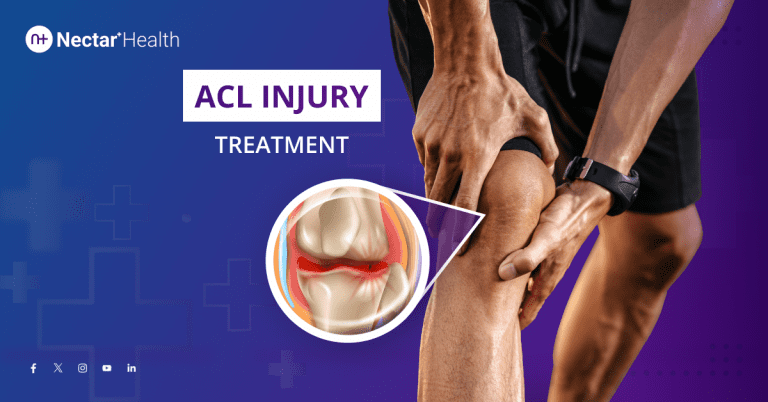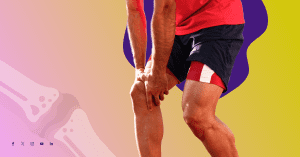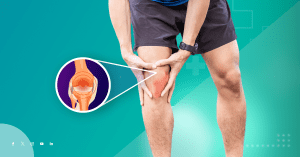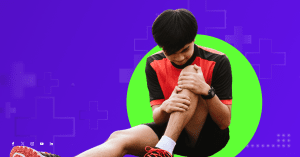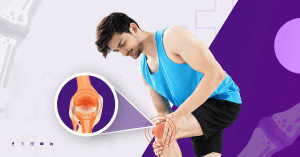What is ACL Injury?
The anterior cruciate ligament (ACL) is a ligament that helps to stabilize the knee joint. It runs from the front of the shinbone (tibia) to the back of the thighbone (femur). The ACL helps to prevent the shinbone from sliding forward out of place.
An ACL injury is a tear or sprain of the ACL. ACL injuries are most common in athletes who participate in sports that involve sudden changes in direction, such as basketball, football, and skiing.
An ACL (Anterior Cruciate Ligament) injury is a common orthopedic issue that can affect individuals of all ages and activity levels. Whether you’re an athlete or not, understanding what an ACL injury is, how it happens, its symptoms, and treatment options is essential. In this blog, we’ll delve into the details of ACL injuries to help you grasp the basics of this common knee problem.
What Is the ACL? The ACL is one of the four major ligaments in the knee joint. It plays a crucial role in maintaining the knee’s stability and function. It connects the thigh bone (femur) to the shinbone (tibia) and is responsible for preventing excessive forward movement of the tibia in relation to the femur.
Causes of ACL Injury
ACL injuries are most commonly caused by sudden twisting or pivoting movements of the knee. This can happen when you are playing sports, but it can also happen during everyday activities, such as walking or running.
Other risk factors for ACL injuries include:
- Age: ACL injuries are more common in young adults, especially women.
- Muscle weakness: People with weak hamstrings and quadriceps muscles are more likely to tear their ACL.
- Neuromuscular control problems: People with poor neuromuscular control, which is the ability to coordinate the muscles around the knee, are also more likely to tear their ACL.
- Previous knee injury: People who have had a previous knee injury, such as a meniscus tear or patellar dislocation, are more likely to tear their ACL.
Diagnosis of ACL Injury
If you think you may have torn your ACL, it is important to see a doctor right away. Your doctor will perform a physical examination and ask you questions about your symptoms and how the injury occurred.
If your doctor suspects that you have torn your ACL, they may order an MRI scan. An MRI scan is a type of imaging test that can create detailed images of the inside of your knee joint.
Cost of ACL Injury Treatment
The cost of ACL injury treatment can vary depending on a number of factors, including the severity of the injury, the type of surgery performed, and your insurance coverage.
In general, ACL surgery is a relatively expensive procedure. The average cost of ACL surgery in the India is between ₹1 Lac – ₹3 Lac. However, the cost can be significantly higher or lower depending on the factors mentioned above.
How to Find the Best Surgeon for ACL Injury Treatment
When choosing a surgeon to perform your ACL surgery, it is important to consider the following factors:
- Experience: The surgeon should have extensive experience in performing ACL surgery.
- Success rates: Ask the surgeon about their success rates for ACL surgery.
- Reputation: Ask other doctors and patients for recommendations.
- Comfort level: You should feel comfortable with the surgeon and confident in their abilities.
Treatment for ACL Injury
The treatment for an ACL injury depends on the severity of the injury and your activity level.
If you have a partial ACL tear, you may be able to treat the injury with physical therapy. Physical therapy can help to strengthen the muscles around the knee and improve range of motion.
If you have a complete ACL tear, you will likely need surgery to reconstruct the ligament. ACL reconstruction surgery is a complex procedure that involves replacing the torn ACL with a new graft.
How to Identify the Grade of an ACL Tear
There are three grades of ACL tears:
- Grade 1: This is a mild tear that does not cause any instability of the knee joint.
- Grade 2: This is a moderate tear that causes some instability of the knee joint.
- Grade 3: This is a complete tear of the ACL, which causes significant instability of the knee joint.
The grade of your ACL tear can be determined by an MRI scan.
ACL Injury Rehabilitation
Rehabilitation after ACL surgery is essential for restoring range of motion, strength, and stability to the knee joint. The rehabilitation process typically takes six to nine months, but it can vary depending on the severity of the injury and the individual’s healing rate.
The goals of ACL rehabilitation are to:
- Reduce pain and inflammation
- Restore range of motion
- Strengthen the muscles around the knee
- Improve neuromuscular control
- Prevent re-injury
ACL rehabilitation typically begins with a period of rest and immobilization. This is followed by a gradual progression of exercises to strengthen the muscles around the knee and improve range of motion. As the knee joint heals, the exercises become more challenging.
The rehabilitation process is typically divided into three phases:
- Phase 1: This phase focuses on reducing pain and inflammation and restoring range of motion. Exercises in this phase include passive range of motion exercises, such as moving the knee joint through its range of motion by hand, and active range of motion exercises, such as bending and straightening the knee.
- Phase 2: This phase focuses on strengthening the muscles around the knee and improving neuromuscular control. Exercises in this phase include strengthening exercises for the quadriceps, hamstrings, and calf muscles, as well as proprioception exercises, which help to improve the body’s awareness of the position of the knee joint.
- Phase 3: This phase focuses on preparing the athlete for return to sport. Exercises in this phase include plyometric exercises, which are exercises that involve explosive movements, and sport-specific drills.
It is important to note that ACL rehabilitation is an individualized process. The specific exercises that you will perform and the length of time it will take to complete rehabilitation will vary depending on your individual needs.
Here are some tips for success with ACL rehabilitation:
- Be patient and consistent with your exercises. Rehabilitation takes time and effort, but it is essential for a full recovery.
- Listen to your body and don’t push yourself too hard. If you experience pain, stop the exercise and consult with your physical therapist.
- Communicate regularly with your physical therapist. They can help you to track your progress and make adjustments to your rehabilitation program as needed.
With proper rehabilitation, most people who have ACL surgery are able to return to their normal activities and sports participation.
How to prevent ACL Injury?
There are a number of things you can do to prevent ACL injuries, including:
- Strengthen the muscles around the knee. Strong quadriceps, hamstrings, and calf muscles can help to protect the ACL from injury.
- Improve neuromuscular control. Neuromuscular control is the ability to coordinate the muscles around the knee. You can improve neuromuscular control by performing exercises such as balance training and plyometrics.
- Avoid sudden twisting or pivoting movements. Sudden twisting or pivoting movements can put a lot of stress on the ACL, increasing the risk of injury.
- Warm up properly before exercise. Warming up helps to prepare the muscles and ligaments for activity, which can reduce the risk of injury.
- Wear proper footwear. Wearing proper footwear can help to support the ankle and knee joints, which can reduce the risk of injury.
Here are some specific exercises that you can do to strengthen the muscles around the knee and improve neuromuscular control:
- Squats
- Lunges
- Hamstring curls
- Calf raises
- Balance board exercises
- Plyometric exercises, such as box jumps and jump squats
You can also work with a physical therapist or certified personal trainer to develop a personalized exercise program to help you prevent ACL injuries.
If you are involved in sports, it is important to learn the proper techniques for your sport. This can help to reduce the risk of ACL injuries and other sports injuries.
By following these tips, you can help to prevent ACL injuries and enjoy your activities safely.
